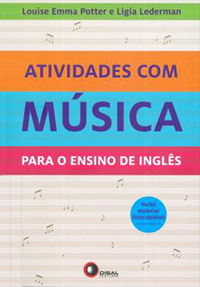By - Samanta Malta*

As a teacher, I had always been hesitant about using textbooks. Each time I had a coursebook to follow, I tried to find a way to recreate the material and use it according to the needs of my students and the teaching principles I believed in. I have taught in different school contexts and taught students from early childhood to adult education. In all these contexts, I realized the more flexible the curriculum was, the more I could do for my students’ development.
Regarding the teaching-learning process of young learners, the other day I heard from my cousin that her five-year-old son already has five-course books to fulfill. This affirmation affected me. My cousin's son is already filling up book pages in his first year at school. Personally, I do not believe children can learn by having coursebooks as their primary learning tool. I truly believe people of all ages, better learn when they live, experience, discuss, interact, and reflect on their learning objectives.
Experiential learning approaches provide teaching-learning contexts through experiences and interaction. Reggio Emilia and Montessori are the two best-known experiential approaches in early childhood education. Both methods have the children in the center of the teaching-learning process and work with a flexible and individualized curriculum. The teachers are learning mediators rather than instructors.
In Reggio, teachers build the curriculum by observing and interacting with the students. The classes are based on projects initiated mostly by the students or the teachers, and play is an essential role in the teaching-learning process. The children are encouraged to work in pairs or groups and express their feelings and knowledge using different modes of learning such as drawing, painting, music, dance, poetry, stories, role plays, and more (EDWARDS, GANDINI, FORMAN, 1999).
In Montessori schools, children are encouraged to develop their independence. They can work on the learning tasks that most suit them. They use a lot of manipulatives as movable alphabets, rods, and geometric tablets in their classes (ALJABREEN, 2020). Play is less used in Montessori classes than in Reggio Emilia.
In this article, I would like to share my experiences with a different experiential learning approach called Performative Play (MALTA, 2015). It is a free or guided play-based approach centered on Social Activities (LIBERALI, 2009). In this approach, children interact with other children, adults, and objects in social activities that, at the moment, are beyond their reach such as being a chef in a restaurant, choosing a traveling destination, buying traveling tickets, and so on.
The teachers play an essential but not central role. They are responsible for creating a developmental teaching-learning space, engaging, and challenging the children.
The curriculum is flexible and built according to the children’s needs. The development of the teaching-learning content happens across social activities such as going to the doctor/supermarket, organizing a birthday party, traveling abroad, etc.
As soon as the social activity is set, it is time to think about the components. For example, in the social activity traveling abroad, teachers and children discuss the people involved in the action as themselves, their parents, traveling agent, flight attendant, etc. They also discuss the reasons for their traveling as wanting to know a specific place, visiting a family member, etc. They talk about and choose the instruments used in the activity as a boarding pass, suitcase, money, and the appropriate oral and written discourses. Rules and task division are also discussed and applied in the play. The teachers use the components of the social activity to build the curriculum and develop the classes.
My first experience with the Performative Play approach was with children from two to four years old in a daycare center in São Paulo. It was part of an academic project called Multicultural Education Project which I had the pleasure to work for for two years. The aim was to provide the children opportunities to experience social interactions that they were not used to and introduce a new language, in this case, English, through social activities in a bilingual-like context.
The classes followed a routine: welcome – hello song – developmental tasks – performative play - closing (bye, bye song) and had a social and academic target. We used a variety of modes of learning (storytelling, language games, videos, music, and more) to provide the children with a better understanding of the social activity.
The performative play project I loved most was the one that involved the social activity - Going to Bed. It lasted half of a semester with thirty minutes of class a week. Once the children got acquainted with the new language, they started to use it. During the play moments, we observed the children's social and academic development. I saw a boy putting a doll to sleep. I observed a child discussing (in English and Portuguese) with one of the teachers, the things they do before going to sleep; I saw a girl performing reading a book to a doll. Besides that, the children sang the songs like Twinkle, Twinkle, Little Star, recognized and used words such as drink, read, book, water, and milk.
In this teaching-learning context, the new language was developed while the children acquired content other than the English language. And most importantly, they were immersed in social activities through performative play that allowed them to live and experience the language in new social contexts.
As you could notice, we did not use coursebooks in any of these classes. Language and content were developed across social activities providing the children with new ways to live and interact in a new language.
References
ALJABREEN, H. Montessori, Waldorf, and Reggio Emilia: A Comparative Analysis of Alternative Models of Early Childhood Education. International Journal of Early Childhood 52:337–353. Dez. 2020.
EDWARDS, C. GANDINI, L. FORMAN, G. Aspectos Gerais. In: Cem Linguagens da Criança – A Abordagem de Reggio Emilia na Educação da Primeira Infância. (Traduçao) DAYSE, B Porto Alegre: Artmed, 1999/2008.
LIBERALI, F.C. Atividade Social nas Aulas de Língua Estrangeira. São Paulo: Editora Moderna, 2009.
MALTA, S. P. S. Aprender brincando em língua estrangeira: uma perspectiva dos Multiletramentos na educação infantil. Dissertação. 242f. - Linguística Aplicada e Estudos da Linguagem. PUC/SP. 2015.
LIVRO RECOMENDADO
